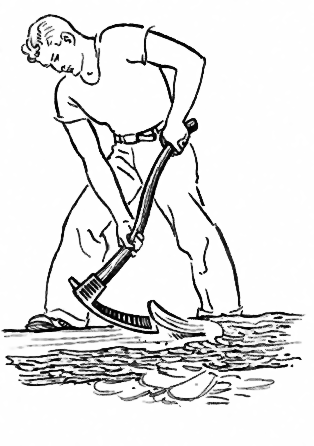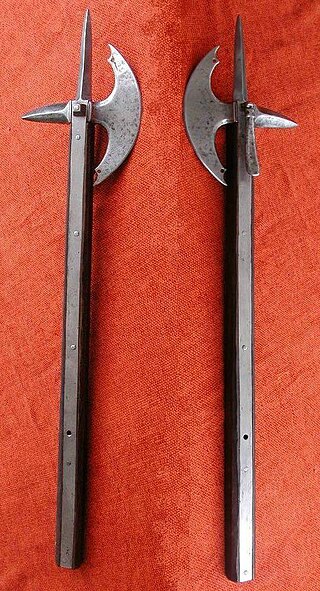
A hammer is a tool, most often a hand tool, consisting of a weighted "head" fixed to a long handle that is swung to deliver an impact to a small area of an object. This can be, for example, to drive nails into wood, to shape metal, or to crush rock. Hammers are used for a wide range of driving, shaping, breaking and non-destructive striking applications. Traditional disciplines include carpentry, blacksmithing, warfare, and percussive musicianship.

A polearm or pole weapon is a close combat weapon in which the main fighting part of the weapon is fitted to the end of a long shaft, typically of wood, extending the user's effective range and striking power. Polearms are predominantly melee weapons, with a subclass of spear-like designs fit for thrusting and/or throwing. Because many polearms were adapted from agricultural implements or other fairly abundant tools, and contained relatively little metal, they were cheap to make and readily available. When belligerents in warfare had a poorer class who could not pay for dedicated military weapons, they would often appropriate tools as cheap weapons. The cost of training was comparatively low, since these conscripted farmers had spent most of their lives using these "weapons" in the fields. This made polearms the favoured weapon of peasant levies and peasant rebellions the world over.

Woodworking is the skill of making items from wood, and includes cabinetry, furniture making, wood carving, joinery, carpentry, and woodturning.

An adze or adz is an ancient and versatile cutting tool similar to an axe but with the cutting edge perpendicular to the handle rather than parallel. Adzes have been used since the Stone Age. They are used for smoothing or carving wood in hand woodworking, and as a hoe for agriculture and horticulture. Two basic forms of an adze are the hand adze —a short-handled tool swung with one hand—and the foot adze (hoe)—a long-handled tool capable of powerful swings using both hands, the cutting edge usually striking at foot or shin level. A similar tool is called a mattock, which differs by having two blades, one perpendicular to the handle and one parallel.

A broadaxe is a large (broad)-headed axe. There are two categories of cutting edge on broadaxes, both are used for shaping logs by hewing. On one type, one side is flat, and the other side beveled, a basilled edge, also called a side axe, single bevel, or chisle-edged axe. On the other type, both sides are beveled, sometimes called a double bevel axe, which produces a scalloped cut.

In woodworking, hewing is the process of converting a log from its rounded natural form into lumber (timber) with more or less flat surfaces using primarily an axe. It is an ancient method, and before the advent of the industrial-era type of sawmills, it was a standard way of squaring up wooden beams for timber framing. Today it is still used occasionally for that purpose by anyone who has logs, needs beams, and cannot or would prefer not to pay for finished lumber. Thus, homesteaders on frugal budgets, for example, may hew their own lumber rather than buy it.

A tomahawk is a type of single-handed axe used by the many Indigenous peoples and nations of North America. It traditionally resembles a hatchet with a straight shaft. In pre-colonial times the head was made of stone, bone, or antler, and European settlers later introduced heads of iron and steel. The term came into the English language in the 17th century as an adaptation of the Powhatan word.

An ice axe is a multi-purpose hiking and climbing tool used by mountaineers in both the ascent and descent of routes that involve snow, ice, or frozen conditions. Its use depends on the terrain: in its simplest role it is used like a walking stick, with the mountaineer holding the head in the center of their uphill hand. On steep terrain it is swung by its handle and embedded in snow or ice for security and an aid to traction. It can also be buried pick down, the rope tied around the shaft to form a secure anchor on which to bring up a second climber, or buried vertically to form a stomp belay. The adze is used to cut footholds, as well as scoop out compacted snow to bury the axe as a belay anchor.

A battle axe is an axe specifically designed for combat. Battle axes were specialized versions of utility axes. Many were suitable for use in one hand, while others were larger and were deployed two-handed.

A vise or vice is a mechanical apparatus used to secure an object to allow work to be performed on it. Vises have two parallel jaws, one fixed and the other movable, threaded in and out by a screw and lever.

A billhook or bill hook, also called a pruning knife or spar hook, is a versatile cutting tool used widely in agriculture and forestry for cutting woody material such as shrubs, small trees and branches. It is distinct from the sickle. It was commonly used in Europe with an important variety of traditional local patterns. Elsewhere, it was also developed locally such as in the Indian subcontinent, or introduced regionally as in the Americas, South Africa, and Oceania by European settlers.

The doloire or wagoner's axe was a tool and weapon used during the Middle Ages and Renaissance. The axe had a wooden shaft measuring approximately 1.5 metres (5 feet) in length and a head that was pointed at the top and rounded at the bottom, resembling either a teardrop or an isosceles triangle. The top of the shaft was fitted with a metal eye or socket that was welded to the head of the axe near the base of the blade. The upper part of the blade extended above the eye, while the opposite side of the socket featured a small blunt hammer head. The head of the axe itself measured approximately 44 cm. (17 inches) in length, was sharpened on the back and flattened bottom edges, and was uniformly decorated with punched and incised abstract floral patterns.

The Woodwright's Shop is an American traditional woodworking show hosted by master carpenter Roy Underhill and airing on television network PBS. It is one of the longest running how-to shows on PBS, with thirty-five 13-episode seasons produced. Since its debut in 1979, the show has aired over 400 episodes. The first two seasons were broadcast only on public TV in North Carolina; the season numbering was restarted when the show went national in 1981. It is filmed at the UNC-TV studios in Research Triangle Park, North Carolina.
"Bury the hatchet" is an American English idiom meaning "to make peace". The phrase is an allusion to the figurative or literal practice of putting away weapons at the cessation of hostilities among or by Native Americans in the Eastern United States.

An axe is an implement that has been used for millennia to shape, split, and cut wood, to harvest timber, as a weapon, and as a ceremonial or heraldic symbol. The axe has many forms and specialised uses but generally consists of an axe head with a handle, also called a haft or a helve.

A twybil is a hand tool used for green woodworking. It is used for chopping out mortises when timber framing, or making smaller pieces such as gates. It combines chopping and levering functions in a single tool.

Hacking or side knives may be considered as either light hatchets or heavyweight knives.

Native American weaponry was used by Native American warriors to hunt and to do battle with other Native American tribes and European colonizers.

Carpenter's axes or Carpenter's hatchets are small axes, usually slightly larger than a hatchet, used in traditional woodwork, joinery and log-building. They have pronounced beards and finger notches to allow a "choked" grip for precise control.




















